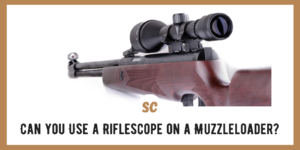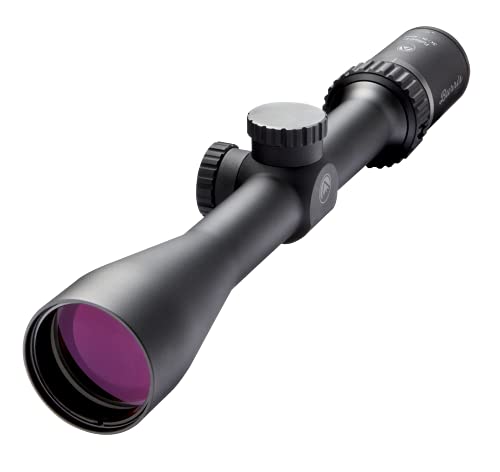Like many hunters and sport shooters, you probably started shooting standard bolt action hunting rifles. In most cases, your hunting rifle had a standard optical riflescope. As your shooting career progressed, this was the standard setup. Now you are branching out and have acquired a muzzleloader. The question you have is whether you can use one of your riflescopes on your new muzzleloader.
Under most circumstances, a standard optical riflescope will work on a muzzleloading rifle. Many modern muzzleloading rifles feature ballistics comparable to some centerfire rifles. These similarities lend themselves to adopting a standard optical riflescope to a muzzleloading rifle. You should understand and observe some exceptions.
Muzzleloading rifles do offer some advantages over a centerfire bolt-action rifle. In many places, those using a muzzleloading rifle enjoy a special or extended hunting season. A modern muzzleloader equipped with the right optics can be as efficient and accurate as any other rifle. Riflescopes can be used on muzzleloaders if the scope meets some special requirements.
SKIP AHEAD
What Are the Differences Between a Riflescope and a Muzzleloader Scope?
The differences between scopes for muzzleloaders and rifles go back to the differences in muzzleloaders and centerfire rifles. To make an informed decision on the scope of a muzzleloading rifle, you need to understand how centerfire rifles and muzzleloading rifles affect scopes.
The Effects of Recoil on Your Scope
Both centerfire rifles and muzzleloading rifles deliver significant recoil. Recoil is the energy backward when the gun fires. Everything mounted on the rifle and the shoulder of the shooter absorbs some of this energy. The scope mounted on your rifle must withstand this energy with each shot.
Typically, muzzleloading rifles deliver more recoil than centerfire rifles. Muzzleloading rifle scopes are more robust to withstand this higher recoil. Riflescopes may not have the structural integrity to withstand the recoil from a muzzleloading rifle.
The Parallax Questions for Muzzleloaders
Long-range shooters typically understand the questions of parallax. In simple terms, parallax causes focus problems on riflescopes used for long-range shooting. At great distances, the reticle may appear out of focus with the target or vice-versa. The factory parallax setting on most riflescopes is between 100 and 125 yards.
Muzzleloading rifles are rare used for shots longer than 150 yards. For this reason, factory parallax settings between 50 and 75 yards are normal. This shorter parallax setting ensures that the reticle and target image in your scope remain close to the same.
Reticle Choices and Designs
The ballistic characteristics of modern centerfire rifles and modern muzzleloading rifles are quite different. Muzzleloading bullets are usually much larger and heavier than centerfire rifles. By nature, these larger and heavier bullets are slower and have different ballistic characteristics.
Centerfire rifle reticles often include a bullet drop compensation feature. There is no way to adjust a rifle reticle for muzzleloader ballistics. If you are accustomed to using a bullet drop compensating reticle, this can be a problem. The better solution is to mount a scope designed for your muzzleloader with the correct bullet drop compensating reticle.
Staying Far Enough Away from Your Scope
Eye relief is one of those technical specifications found with most scopes. Many shooters never think about or consider eye relief when they purchase a new rifle scope. However, when you consider a scope for a muzzleloading rifle, eye relief takes on a new importance.
Muzzleloading rifles tend to develop more recoil than modern centerfire rifles. This increased energy drives the rifle further backward after the shot. Muzzleloading rifles require longer eye relief than centerfire rifles. Typically, a muzzleloading rifle requires an eye relief of at least four inches. Most centerfire rifle scopes have eye relief between 3.4 and 23.7 inches.
What Should I Look for in a Scope for my Muzzleloader?
You should consider all the things you would look for in any scope. Among the things we recommend as factors to consider in a riflescope are:
- Quality of Construction
- Durability
- Clarity
- Magnification
- Warranty
- Cost
These are factors that affect any scope. There are other factors to consider when choosing a scope for a muzzleloading rifle. In addition to these basic functional parts of choosing a scope, a muzzleloading riflescope requires you to consider these factors.
- Eye relief
- Resistance to recoil
- Reticle style and design
It would help to consider your preferences and expectations when choosing a new scope for your muzzleloader. Finding the right fit for your muzzleloader and your needs is a critical issue.
Do I Need A variable Magnification Scope on my Muzzleloader?
When looking for a new scope for your muzzleloading rifle, many shooters wonder whether they should opt for a fixed or variable power scope. Opinions vary about whether a variable magnification scope has any advantage over a fixed power scope.
The debate brings up some interesting arguments. You should consider these arguments. Some may not affect you, while others may become priority items as you search for a scope for your muzzleloading rifle.
Do I Need Higher Magnification?
Variable magnification scopes are very useful when you routinely shoot at extreme ranges need all the help they can get to see their targets. Muzzleloaders never approach those distances, so the argument for variable magnification is not about going long distances.
What many hunters and shooters face are age and eyesight. As we age, our eyesight becomes less sharp. Even at the much shorter ranges than most muzzleloaders shoot, the advantage of some additional magnification helps. Even a 3 x 9 variable magnification scope can make a difference for some whose eyesight is not what it once was.
What is the Best Reticle for a Muzzleloading Rifle?
Finding the reticle design that works best for you is a very personal decision. Your shooting style and the type of shooting you do all figure into this decision. Among the things to consider when choosing a reticle are the following.
Traditional Crosshair Reticles
When most of us think of a scope reticle, the traditional cross-shaped aiming aid comes to mind. The plus-shaped reticle is probably the best-known style of scope reticle. However, there are some cons to the standard crosshair reticle.
- A standard crosshair can be hard to see under some light situations
- There are no aids to aiming with a standard crosshair, such as drop compensation
- Standard crosshairs don’t offer any help with estimating distance or adjustments for windage or elevation.
You won’t find many muzzle-loading riflescopes with a standard crosshair. The difficulty in using a plain crosshair and the advantages offered by a more elaborate reticle style create obstacles for most shooters.
Bullet Drop Compensating Reticles
Many scope manufacturers now offer muzzleloader scopes that feature bullet drop compensating reticles. The calibration on these muzzleloading bullet drop compensating reticles work with the heavier bullets and different powder loads. Using a good bullet drop compensating reticle can extend the range of your muzzleloading rifle and allow you more shot opportunities on your targets.
Mil-Dot or MOA Reticles
You can purchase a scope for your muzzleloader calibrated for either Mil-Dot or MOA. Consistency is always a good option. If your riflescopes are calibrated in MOA, choosing a muzzleloading scope calibrated the same makes sense. Having the same calibration makes moving from one to the other much easier.
Who Builds the Best Scopes for Muzzleloaders?
Several of the most well-known optics companies are now producing dedicated muzzleloader scopes. Buying from a reputable and known manufacturer is a great way to ensure that your scope performs to your satisfaction. Among the best muzzleloader scopes, we found are the following.
Leupold UltimateSlam 3-9x40mm
If you look for quality, durability, and superb optics, you won’t be disappointed by the Leupold UltimateSlam 3-9x40mm. Match all the features with Leupold’s reputation as a world-class optics manufacturer, and you get great value and quality. You can expect features from Leupold like:
- Made in the USA
- Great lowlight performance
- Low power eye relief – 4”
- 3x – 9x magnification
The advantage of the Leupold name on the scope gets you more than just a reputation for quality. Leupold backs up their scopes with one of the best warranties on the market.
Last update on 2024-04-19 at 06:42 / Affiliate links / Images from Amazon Product Advertising API
Vortex Crossfire II 3-9X40mm
Vortex builds such a wide variety of scopes that you can find one to fit almost any application. Vortex Optics Crossfire II 3-9x40mm scope is an almost perfect fit for any muzzleloading rifle application. Buying a Vortex Crossfire scope gets you a great list of features.
- Great clarity and light-gathering optical performance
- Fast focus eyepiece
- 3.8-inch eye relief
- MOA turrets
Vortex Optics have built a reputation on their customer service. At the heart of this customer service reputation is their no-questions-asked lifetime warranty. Vortex will repair or replace your scope when damaged, no matter the cause of the damage.
Burris™ FullField E1 Muzzleloader Scope
Burris is an often overlooked scope manufacturer. However, Burris has a long history of building high-quality optics in the United States. Burris includes several muzzleloader-specific scopes in their line. Our favorite is the FullField E1 Muzzleloader Scope. Not only is this scope designed for muzzleloader use, but it also incorporates all the Burris optics line features.
- The simple reticle design works well with muzzleloading rifles
- Highly durable internal design withstands high recoil and shock with ease
- Nitrogen field and sealed for fog proof operation
- With the Burris Muzzleloader Ballistic Plex Reticle
Burris covers their optics with their Forever Warranty. Burris promises no cost for repairs or warranties, no warranty registration, and no receipts needed to repair or replace your damaged scope. That kind of customer service can be a godsend to anyone who hunts in extreme conditions.
- Covered under for life
- Made using the highest quality materials
Last update on 2024-04-19 at 06:42 / Affiliate links / Images from Amazon Product Advertising API
Nikon Prostaff P3 Muzzleloader Riflescope
Unfortunately, Nikon ceased producing rifle scopes in 2019. However, the inventory of Nikon is largely still available through large volume dealers and discounters. If you can find someone holding a Prostaff P3 Muzzleloader Riflescope stock, it is a good investment in muzzleloader optics. You will get features that include:
- The simple to use BDC300 reticle for quick and easy target acquisition
- Instant zero-reset turrets
- Generous eye relief
- Nikon is still honoring warranties on these scopes
Nikon made some great riflescopes but decided to concentrate their attention on other business areas. This was a great loss to the shooting world. The Nikon Prostaff scope is a great addition to any muzzleloader rifle.
- Fully Multicoated Optical System
- BDC 300 Reticle
Last update on 2024-04-19 at 06:43 / Affiliate links / Images from Amazon Product Advertising API
Optics for Your Muzzleloader – Make the Best Choice
You can, of course, mount your spare centerfire rifle scope on your muzzleloader rifle. Many people do this and find the results more than acceptable by some accounts. On the other hand, you can invest in an optical scope the fits your rifle and its special needs. Our recommendation is always to fit your scope to your rifle for the best results.








